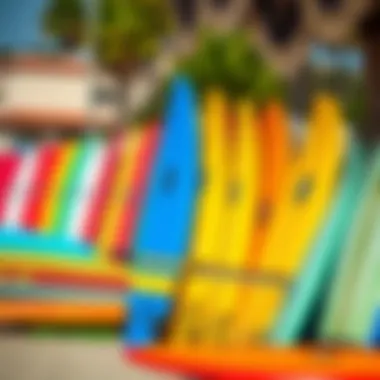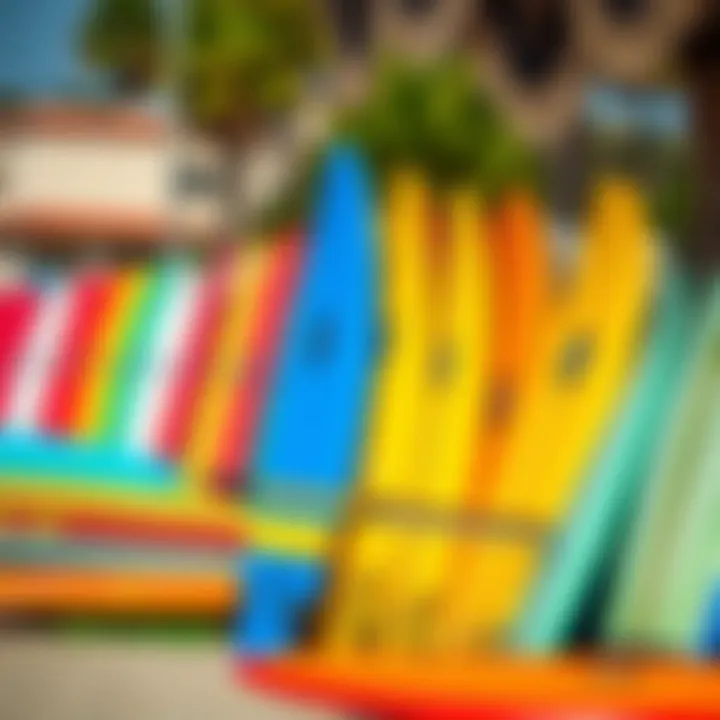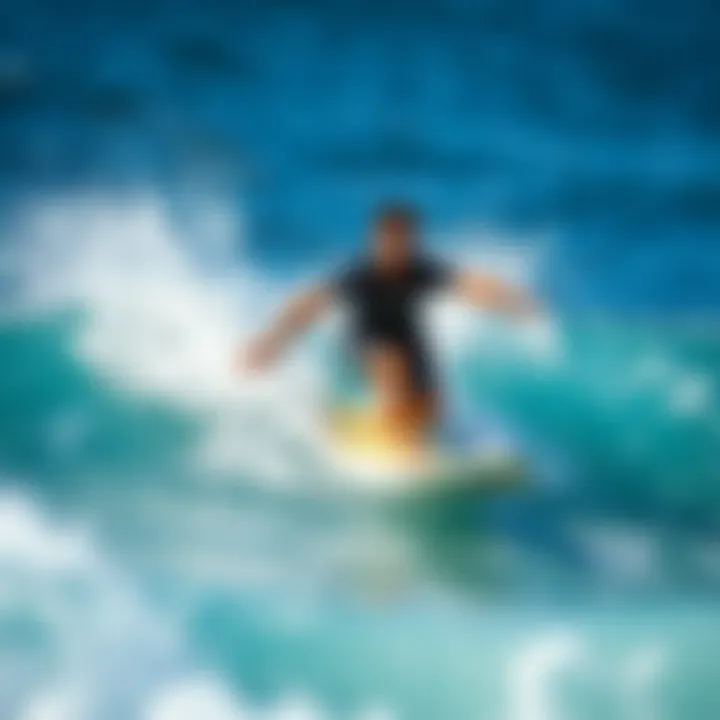Surfboard Rentals in Mission Beach: A Complete Guide


Intro
Surfing at Mission Beach is more than just a hobby; it’s a lifestyle, a culture, and for many, it’s a way to connect with nature. With miles of picturesque coastline, crystal-clear waters, and consistent waves, this spot draws in surfers of all skill levels. As the sun rises over the horizon, casting a golden hue over the water, anticipation fills the air. However, before diving headfirst into the ocean’s embrace, having the right equipment is crucial. For both novices eager to catch their first wave and seasoned pros navigating the crests like a seasoned captain, understanding the dynamics of surfboard rentals can elevate one’s experience immensely.
Renting a surfboard can be daunting, especially for those unfamiliar with the intricate details of gear choice, local rental shops, and the variety of surfboards available. Many rental shops dot the beach area, offering everything from the classic longboards to agile shortboards. How does one know what to choose? What factors ought to influence these choices? Here, we aim to demystify the surfboard rental process, paving the way for a smooth ride on the waves ahead.
Understanding the ins and outs of surfboard technology, the essential skills needed to ride, and more will ensure that your time in the water isn’t just enjoyable, but enriching. As we sail through this guide, you’ll gain insight into not just the technical aspects of surfing but the communal spirit that thrives at Mission Beach. So tighten your leash, because here we go!
Understanding Mission Beach as a Surfing Destination
Mission Beach, with its picturesque coastline stretching for miles, is more than just a spot on the map for surfers; it’s a veritable melting pot of wave riders, who each have their unique story and connection to the ocean. Before diving into surfboard rentals or hitting the waves, understanding Mission Beach as a surfing hotspot is essential for anyone looking to enjoy the surfing life here.
Geography and Wave Conditions
One cannot help but notice the geographical charm that Mission Beach contains. With its golden sands and rolling waves, the beachfront makes it a most desirable destination, both for novices attempting their first ride and seasoned professionals chasing the perfect wave. The coastline is exposed to various swells, giving surfers a consistent opportunity to paddle out any time of the year.
The wave conditions can be quite dynamic, influenced by seasonal shifts. The summer months provide generally gentle waves, perfect for beginners. However, autumn can usher in larger swells, creating exhilarating conditions for the more experienced. It’s worth noting the local surf reports or observing the conditions firsthand can make a real difference in choosing when to surf. For those keen on cherry-picking the best times, checking websites like Surfline can offer insights into tide charts and swell forecasts.
Cultural Significance of Surfing in the Area
Surfing holds cultural weight in Mission Beach, deeply embedded in the fabric of local life. The community here embraces surfing not just as a sport, but as a lifestyle. From organized beach clean-ups to surf competitions, the surfers of this coastline are united in their care for the environment and the culture that surrounds them.
In a way, surfing has become a rite of passage for young locals, and it nurtures a sense of camaraderie that transcends age and skill levels. The well-trodden path from the sandy beach to the water is lined with the stories of countless surfers who have waxed poetic about their experiences here. For many, the phrase, "Get in the water, feel alive" captures the exhilarating essence that surfing brings.
Surfing here is not just about catching waves; it's the shared laughter, the stories swapped, and sometimes, the falls that forge memories together in this vibrant community.
In essence, understanding Mission Beach—its geography, wave conditions, and the culture of surfing—is crucial for making informed decisions about surfboard rentals and embracing the overall surfing experience here. This knowledge lays a solid foundation as one progresses into choosing the right equipment, navigating rental options, and ultimately, enjoying the surf to its fullest.
The Surfboard Rental Market Overview
Understanding the market for surfboard rentals is essential, especially for those planning to surf at Mission Beach. This area serves as a hub for both newcomers to the sport and seasoned surfers looking for short-term options without the burden of carrying equipment. Knowing what’s available and the conditions of the rental market can enrich your surfing experience. Whether you’re drawn to the waves for the thrill or the relaxation of being near the ocean, the rental landscape allows you to customize your experience without the long-term commitment.
Types of Rentals Available
When it comes to surfboard rentals in Mission Beach, surfers have an array of choices tailored to various skill levels and preferences. Each type of board offers unique benefits, catering to the diverse needs of surfers.
Longboards
Longboards are often favored for their stability and ease of use, making them a prime choice for beginners and those looking for a leisurely ride. With a longer length, typically ranging from 8 to 12 feet, they offer a smoother glide and better balance on smaller waves.
One of the standout features of longboards is their ability to nose ride, providing a sense of grace as one rides the waves. This feature makes them particularly attractive for older surfers who might be returning to the sport, or for anyone seeking a more laid-back surfing experience. However, longboards can be cumbersome to transport and maneuver in heavy surf conditions, which is a trade-off to consider.
Shortboards
On the other hand, shortboards are all about speed and maneuverability. Typically measuring between 5 to 7 feet, these boards are designed for those who want to cut through waves with agility. Experienced surfers usually prefer shortboards for advanced techniques like rails and aerial tricks.
A key characteristic of shortboards is their lightweight design, which allows for rapid movements on the water. However, they can be tricky for beginners, as mastering balance and control requires practice. The steep learning curve is a potential downside, as beginners may find themselves struggling more compared to using longboards.
Funboards
Funboards strike a balance between longboards and shortboards, which makes them an appealing option for many surfers. Measuring between 7 to 8 feet, they incorporate characteristics of both types, offering good buoyancy and maneuverability without the heaviness of a longboard or the quickness of a shortboard.
This versatility allows surfers to use funboards across varied conditions, making it a great rental choice if the surf is unpredictable. However, for those aiming to master more advanced techniques, funboards might not cater to that desire as effectively as a specialized board. So, they are great for casual days at the beach but not necessarily for honing advanced skills.


Soft-Top Boards
Soft-top boards have gained traction due to their safety features, particularly valuable for novices who may take some spills. The foam design reduces the risk of injury, making it a preferred choice for families introducing children to surfing.
Their durability against typical wear and tear also appeals to those renting, as they require less meticulous care. The drawback lies in performance; although they are friendly for newbies, they may lack some of the precision and responsiveness found in traditional hard-top boards. Therefore, soft-tops cater well to short-term rentals where users prioritize safety over advanced performance.
Seasonal Trends in Rentals
Like any beach destination, Mission Beach has its seasonal patterns that affect rental rates and availability. Summer sees a spike in tourists and families wanting to hit the waves, consequently leading to an increase in rental demand. Expect bustling shops and perhaps less personal attention. In contrast, the off-peak months might provide an opportunity for better deals and more attentive service. Keeping track of these trends can help surfers not only save money but also enjoy a less crowded experience on the water.
In short, understanding the surfboard rental market in Mission Beach allows renters to tailor their surfing experience to their skill level and style, whether they're just dipping their toes in or looking to carve up some serious waves.
How to Choose the Right Surfboard Rental
Choosing the right surfboard rental is a crucial step in ensuring an enjoyable day on the waves at Mission Beach. With some factors to consider, it can significantly enhance one’s surfing experience. First off, understanding what you need as a surfer can mean the difference between an epic ride and a day of frustration. This section dives deep into assessing your skill level and pinpointing board types that match your surfing conditions. Whether you’re a novice finding your feet or a seasoned pro catching swells, making informed decisions is key to riding those waves.
Assessing Your Skill Level
Understanding where you stand in your surfing journey is fundamental when it comes to renting a board. Here's a quick breakdown to help you determine your skill level:
- Beginner: If you're just starting out, you’ll likely benefit from a broader and more stable board, which helps in catching waves and maintaining balance. Soft-top surfboards are popular among novices, as they provide more cushioning if you take a tumble. These boards are less intimidating and usually come with some built-in safety features.
- Intermediate: For those who have got the hang of things but are still learning some tricks, a funboard could be a good option. These boards offer a balance between stability and mobility, perfect for experimenting with different maneuvers.
- Advanced: Experienced surfers might want to get their hands on shortboards or performance boards. These are snappier and allow for more aggressive turns, making them ideal for those looking to carve through waves and catch faster swells.
When selecting your board, it’s wise to be honest about your ability level. A board that’s too advanced can lead to dissatisfaction and possibly accidents on the surf.
Identifying Suitable Board Types for Conditions
Once you’ve assessed your skill level, the next step is to identify which types of boards are best suited for the prevailing wave conditions at Mission Beach. Waves come in different shapes, sizes, and powers, which necessitates choosing the right board. Here’s how you can determine what to rent:
- Small, mellow waves: If the surf is calm, a longer board, like a longboard or funboard, can make for a more enjoyable experience. They provide greater paddle power and stability, increasing your chances of catching those gentle waves.
- Choppy, inconsistent surf: When facing messy waves, a shortboard can be beneficial. These boards are generally lighter and more maneuverable, making them easier to handle when trying to navigate through turbulent waters.
- Big swells: For larger waves, consider using a performance shortboard. Their streamlined shapes are designed for speed and optimal wave cutting, allowing skilled surfers to handle heavier surf conditions.
It’s helpful to have a chat with local surf shops about the current conditions and get recommendations. They know the area like the back of their hand and can point you towards suitable rentals for the day’s surf.
"Your choice of surfboard has a direct say in your surfing experience. Understanding your skill level and the wave conditions is vital for making the right decision."
Remember, taking the time to think through these two elements —your skill and the surf conditions—can dramatically elevate your surfing adventure at Mission Beach. Thoughtful choices lead to a fulfilling day on the water.
Top Rental Shops in Mission Beach
In the realm of surfing, where the tide and waves dictate the experience, finding the right surfboard rental shop can make a world of difference. In Mission Beach, the abundance of rental shops offers a range of options for both novices and seasoned surfers alike. This section delves into some of these shops, showcasing their unique offerings and addressing why each is a viable choice for surfers aiming to catch the perfect wave.
Shop Profiles
Shop A: Overview and Services
One standout in the Mission Beach surfboard rental scene is Pacific Surfer Rentals. This shop easily earns its stripes due to its extensive selection of boards—their inventory includes longboards, shortboards, and soft-top boards, catering to all skill levels. A major draw of Pacific Surfer Rentals is its knowledgeable staff, often described as friendly and eager to assist. They take the time to match you with a board that fits not just your skill level, but also the current wave conditions.
Moreover, the shop offers a range of services beyond rentals, including surf lessons for beginners and guided surf tours for those wanting to explore less crowded spots. The distinctive aspect of Pacific Surfer Rentals lies in its community feel; they frequently host local surf meetups, creating a vibrant hub for enthusiasts. Overall, this shop stands as a popular choice because it not only meets rental needs but also fosters a diving community spirit among surfers.
Shop B: Customer Reviews and Offerings
Another noteworthy player is Mission Surf Shop, garnering rave reviews from patrons. Customers rave about the shop's extensive range of high-performance boards, which are available for rent at competitive prices. It’s recognized for its seamless process, where one can try out various boards without feeling rushed—a factor that many find beneficial when choosing their ideal fit.
What truly sets Mission Surf Shop apart is its commitment to sustainability. They mainly offer eco-friendly rental options, with an emphasis on boards made from recycled materials. Many reviews highlight this aspect, reflecting a growing desire among surfers for environmentally responsible choices. However, some might find the shop's location, slightly off the main beach path, a bit less convenient than other options. Still, its strong focus on customer satisfaction and eco-awareness makes it a beautifully unique choice for anyone looking to catch a wave while being mindful of the ocean.
Comparison of Rates and Packages


When it comes to rates, rental shops in Mission Beach vary widely.
- Daily Rentals: Expect to pay between $30 to $60, depending on the board type.
- Weekly Rentals: Many shops offer a discount for extended rentals, often ranging from $150 to $300.
Additional aspects to consider include any upfront damage deposits and insurance options, which can change the overall cost. It’s worth noting that seasonal fluctuations might cause prices to spike during peak summer months, making early bookings wise for budget-conscious surfers.
Pricing Structure for Surfboard Rentals
Understanding the pricing structure for surfboard rentals is a crucial aspect that can directly impact your surfing experience in Mission Beach. Having a solid grasp of what you can expect to pay helps surf enthusiasts, whether novices or experts, budget effectively. Prices can vary widely based on several factors, including the type of board you choose, rental duration, and any extra services or gear you might want to add. What you pay isn't just a number; it's essentially the key that unlocks your access to the waves.
Daily vs. Weekly Rentals
When deciding between daily and weekly rentals, take a moment to assess your plans. Are you just dipping your toes in for a day, or are you firmly committed to catching waves throughout the week? Daily rentals often serve short-term visitors, offering flexibility for those who want to explore different board types or switch things up. For instance, if you're in town for a weekend getaway, a daily rental from a local shop might suffice. Prices for these typically range from around $30 to $60, depending on the board type and any accessories.
However, if you have a week ahead of you filled with surfing sessions, going for a weekly rental could be wiser, both for your wallet and your surfing game. Many shops offer deals to entice longer rentals, often dropping the daily price significantly. You might find weekly rates somewhere around $150 to $250 for higher-quality boards, plus the added convenience of knowing you have your gear ready and waiting for you without needing to worry about daily returns.
"Consider your surfing frequency and comfort with board types. It’s worth investing a bit more if it means you'll be out on the water more consistently."
Additional Costs and Fees
As with most rental services, expect some additional costs and fees to creep in. It’s a thoughtful approach to check in with rental shops to understand exactly what may be tacked onto the base rental price. Often these can include:
- Insurance Fees: Some shops offer optional insurance covering damages or loss. They may charge an extra fee, typically ranging from $10 to $20, allowing peace of mind while enjoying the waves.
- Accessories: Need a wetsuit, a leash, or a rash guard? Most rental places offer those too, usually for an extra charge. This could add another $15 to $40 depending on what you need.
- Deposit: Many surfboard rentals also require a security deposit, which can vary from $50 to $200, refundable if the board returns in good shape.
- Late Return Fees: If you’re riding the waves until the sun sets and forget about time, prepare to face late return charges. These fees can add up quickly, making it more than just a minor inconvenience.
It's best to clarify all potential charges upfront when renting a board to avoid surprises later. This awareness can save you not only cash but also a headache, helping you focus on having fun in the surf.
Maintenance and Care of Rental Boards
When you decide to tackle the waves at Mission Beach, understanding how to maintain and care for your rental board is absolutely essential. Surfboards can take a beating from the elements, the waves, and even inexperienced handling. Ensuring your rental board is well-cared-for not only extends its lifespan but also enhances your own surfing experience. Rental shops usually rely on the condition of their boards to keep customers coming back, so your attention to maintenance matters as much to them as it does to you.
Taking care of your board isn’t just about keeping it pristine; it’s about ensuring safety and performance on the water. The last thing you want is to be out there battling the waves when your board suddenly loses its integrity. Regular maintenance helps prevent mishaps and ensures that you can focus on riding rather than worrying about equipment failure. Let's get into some specifics on what you need to do.
Basic Maintenance Requirements
Maintaining a surfboard, particularly a rental, is fairly straightforward but requires diligence. Here are key maintenance tips you should consider:
- Rinse After Use: Always rinse your rental board with fresh water after surfing. Saltwater can cause degradation over time, affecting performance and durability. Even a quick rinse at the beach can make a world of difference.
- Check for Dings: After each use, do a quick inspection of your board. Look for any cracks or damages (also known as "dings"). If you find anything, alert the rental shop before returning; they’d rather fix it than have a bigger issue down the line.
- Avoid Direct Sunlight: Surfboards, especially those with foam cores, can warp if left in direct sunlight. Store your board in a shaded area or consider bringing along a board bag for the extra protection when you’re not in the water.
- Dry It Properly: When drying your board, avoid laying it flat as this can cause it to lose shape. Lean it upright against something soft or hang it in a board bag to maintain its integrity.
- Routine Cleaning: Even though it may not seem like a big deal, giving your board a gentle clean with a soft sponge and mild soap can keep it looking sharp. Avoid harsh chemicals that might ruin the surface.
By sticking with these basic requirements, you’ll set yourself up for a better experience on the waves and help keep rental costs down with less wear on the board.
Returning Rental Boards in Good Condition
Now that you’ve enjoyed your time surfing, returning the board in good shape is just as critical. It reflects not only on your responsibility but also ensures you won’t incur extra charges for damages. Here’s what you should focus on:
- Final Inspection: Before returning, inspect your board one last time just as you did after surfing. Ensure all parts, especially the fins and leash, are intact. It’s better to have a quick check than to wish you had done it after the fact.
- Communicate with Rental Staff: If any damage did occur during your rental, be upfront about it. Many shops appreciate honesty and would rather resolve issues collaboratively.
- Clean It Up: As we discussed earlier, rinsing the board after use helps. Before handing the board back, a quick rinse again shows respect for the rental shop's gear and enhances your relationship with them.
- Return Within the Agreed Time: Consistency matters. If you’ve rented for a specific time frame, returning the board on time avoids any late fees, but it also keeps the shop operating smoothly.
- Feedback: If you had a great experience or ideas for improvement, share that when you return. Rental shops value customer feedback and may even remember you next time you come around.
By following these guidelines, you ensure that both you and the rental company are set up for success. A little care and thoughtfulness go a long way, enriching the overall surfing community at Mission Beach.
In summary: Maintaining and returning your surfboard properly helps create a positive loop of responsibility between renters and rental shops. Keeping boards in good shape not only benefits individual surfers but also sustains the vibrancy of Mission Beach's surfing scene.
Local Regulations and Safety Guidelines
Surfing at Mission Beach isn’t just about catching waves and soaking up the sun; it’s also essential to follow local regulations and safety guidelines. These rules are put in place to ensure that everyone enjoys the ocean safely and respectfully. Understanding these regulations can prevent headaches later and enhances the overall surfing experience.


Understanding Surf Etiquette
Surf etiquette plays a crucial role in maintaining harmony among surfers and between surfers and other beachgoers. Each person in the water has a responsibility to uphold a code of conduct that promotes safety and respect. Here are some key points that illustrate the importance of etiquette:
- Right of Way: The surfer closest to the peak of the wave has the right of way. If someone is already riding a wave, it's best to avoid dropping in on them. This rule helps prevent collisions and keeps the vibe friendly.
- Communicate: If you're paddling out and find yourself near other surfers, use hand signals or just a clear shout to communicate intentions. Whether you’re claiming a wave or signaling a fall, clear communication is key.
- Be Respectful: If you are not familiar with the local crowd, it’s often wise to observe and participate in a respectful manner first. Locals appreciate those who take time to understand their surf breaks rather than just diving right in.
These simple actions foster a more enjoyable atmosphere for everyone involved and reflect positively on surfers as a whole.
Safety Precautions While Surfing
Safety is paramount when surfing, especially in a bustling area like Mission Beach where the waves can introduce unexpected challenges. Here are some important precautions to keep in mind:
- Check Conditions: Before heading out, check the surf report. Winds, tidal changes, and swell sizes can vary throughout the day, which may impact safety. Websites like Surfline and Magicseaweed provide valuable insights.
- Wear a Leash: Always use a leash on your board. This not only prevents your board from becoming a floating hazard but also makes it easier for you to retrieve it if you wipe out.
- Surf with a Buddy: It’s common sense, but many forget - surfing with a buddy system enhances safety. If things go south, having someone there can be critical.
- Know Your Limits: Understand your physical capabilities and the conditions. If the waves look intimidating, it’s better to wait for a calmer day. Pushing your limits can lead to dangerous situations.
- Check for Hazards: Always keep an eye out for rocks, swimmers, and other obstacles. Awareness of your surroundings can prevent accidents that could ruin a day at the beach.
“A safe surfer is a happy surfer.” Understanding these guidelines helps ensures that everyone leaves the water with smiles rather than frowns.
Incorporating local regulations and safety precautions not only enriches your surfing experience but also contributes to a safer environment on and off the beach. Adhering to these principles helps to foster a supportive surfing community, ensuring that Mission Beach remains a top destination for surfers of all levels.
Expert Tips for First-Time Renters
Diving into the world of surfboard rentals can seem like a daunting task, especially if you’re a newcomer to the sport. However, getting it right can significantly enhance your experience in the waves at Mission Beach. This section empowers first-time renters with practical insights and advice, transforming what could be a nerve-wracking encounter into an enjoyable and successful outing. Understanding essential tips ensures you have the right board, avoid unnecessary costs, and make the most of your time in the ocean. Let’s break down what you need to know before hitting the surf.
What to Expect During Your First Rental
As you step into a rental shop for the first time, expect a whirlwind of choices. Surfboards come in various shapes and sizes, each tailored for different skill levels and wave conditions. It's crucial to communicate your experience level to the staff. Whether you're a novice or have surfed a few times, they can help steer you toward the right board. Here are some common expectations:
- Assessment: You might undergo a brief skills assessment, where shop staff will ask about your past experiences.
- Sizing: Board sizes vary significantly. A taller person might not need a longboard, while a beginner could benefit from one for stability.
- Condition Check: Make sure to inspect the board for any damage. Look for cracks or dents; a well-maintained board is vital for safety.
- Demo or Test: Some shops allow you to test a board before committing. Take advantage of this opportunity to get a feel for how the board responds in the water.
Expect lots of friendly faces and, likely, some chatter about wave conditions and surf stories. The community vibe at these shops is often welcoming and helps ease the nerves of first-timers.
Common Pitfalls to Avoid
Renting your first surfboard can be a breeze, provided you steer clear of some common missteps. Here’s a rundown of pitfalls that can transform a fun day into hassle:
- Ignoring Local Conditions: Not understanding the surf report for the day can lead to choosing an unsuitable board. Make sure you check the local surf conditions before making any decisions. Local surf shops often have this information readily available.
- Choosing the Wrong Size: Opting for a surfboard that is too small can hinder your balance and control. Similarly, too large may be cumbersome, especially for those still finding their sea legs.
- Neglecting Safety Gear: Forgetting to rent or bring a leash and wetsuit can lead to chilly swims and tricky situations. Always ask about safety gear during your rental process.
- Not Asking Questions: Don’t hesitate to engage with the staff. They are there to help you. Whether it's tips for best surfing spots or the dos and don'ts of handling your rental, their insights can be invaluable.
Practicing caution and preparing in advance will set you on the right path for an unforgettable surfing adventure on Mission Beach. Remember, each wave is a chance to learn, so embrace the excitement of the unknown!
Sustainable Surfing Practices
As surfers, we have an intrinsic connection with the ocean, a relationship that calls for respect and mindfulness towards the environment. This guide aims to shed light on sustainable surfing practices and why they hold significance for both the surfing community and the health of our oceans. Engaging in surfing invariably leaves a footprint, but understanding sustainable practices can help us minimize negative impacts, preserving the beauty of locales like Mission Beach for generations to come.
Eco-Friendly Rental Options
When renting surfboards, choosing eco-friendly options is more vital than ever. Many rental shops are now stepping up, offering boards crafted from sustainable materials.
- Wooden Boards: Some shops have begun offering boards made from renewable resources such as bamboo or other sustainably sourced woods. These materials not only provide good performance but also help reduce plastic waste.
- Biodegradable Wax: An often-overlooked component of surfboard rentals is the wax used to ensure grip. Eco-friendly wax is made from natural ingredients and doesn’t contribute to ocean pollution. Many shops now carry these options, aligning performance with ecological responsibility.
- Recycled Boards: Look for rental services that have boards created from recycled materials. These products typically incorporate upcycled foam and recycled plastics, promoting a cycle of reuse that benefits the environment.
Selecting boards aligned with these eco-friendly initiatives makes it clear that as surfers, we're committed to leaving a lighter mark on our shrike through sustainable surfboard rentals.
"The ocean is a canvas, and every surfer paints their mark. Let's ensure we keep it clean for the next generation of artists."
Promoting Responsible Surfing
Promoting responsible surfing is not just about individual actions but cultivating a culture of care within the surfing community. Being a responsible surfer means taking actions that protect both fellow surfers and the ocean.
- Respecting Local Wildlife: When surfing, always be aware of the natural habitat around you. Avoid surfing in locations that have sensitive wildlife or breeding grounds, and give a wide berth to seals, sea turtles, and other marine life.
- Leave No Trace: Remove any trash or waste you produce while at the beach. As small as it may seem, every piece of plastic counts. Ensuring that your trash makes it back with you is a small but mighty way to show respect for the environment.
- Educate and Share: If you see others engaging in unsustainable practices, do not hesitate to share your knowledge. Engage fellow surfers in conversations about sustainability and responsible habits – it creates a ripple effect that can lead to significant change.
By choosing to promote responsible surfing, not only do individuals contribute positively to the surfing culture, but they also become advocates for the health of the very waters they ride.
Ultimately, sustainable surfing practices are not merely an option but a responsibility. By supporting eco-friendly rental options and adopting responsible behaviors, surfers can enjoy their beloved passion while aiding the preservation of the oceans and beaches they cherish.



